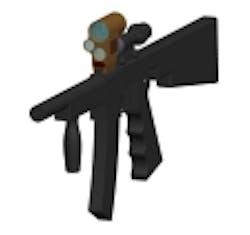Fiber lasers are key enabling electro-optical technologies for One-Shot program's sniper targeting system
AKRON, Ohio, 14 Oct. 2010.Fiber lasers represent perhaps the most crucial enabling technology in the U.S. military One-Shot program to help military snipers hit targets with their rifles at long ranges with only one shot at night, in crosswinds, and in other difficult conditions, say experts at the Lockheed Martin Corp. Mission Systems & Sensors (MS2) segment in Akron, Ohio, prime contractor for the One-Shot sniper targeting initiative.
Military laser experts at the Lockheed Martin Aculight facility in Bothell, Wash., are developing a lightweight fiber laser technology for the One-Shot program, as well as for other precision-engagement technologies under development at Lockheed Martin. This laser not only illuminates the sniper's target at night using a wavelength invisible to the naked eye, but also measures wind speed and direction based on light returns from particles between the shooter and target to compensate for the effects of crosswinds.
"We have realized the importance of small, high-performance fiber lasers," explains John Wojnar, director of business development in the Lockheed Martin Ship and Aviation Systems unit within the company's MS2 division. "We want to take current systems and make them see farther. Adding an active-illumination source, like a fiber laser, enables you to do that."
Lockheed Martin acquired fiber laser specialist Aculight Corp. in Bothell, Wash., in 2008, and relies on Aculight's expertise in weapons-quality fiber lasers as enabling technologies for a variety of precision-engagement systems in addition to the One-Shot program. Aculight now is a business unit of Lockheed Martin MS2 in Akron, Ohio.
The wavelength of the fiber laser that Lockheed Martin uses in the One-Shot program is a military secret, but Wojnar says company experts use wavelength agility technology -- which rapidly hops between a set series of laser wavelengths -- to hide the sniper targeting system's laser illuminator even from specialized laser-detecting equipment. The range of the fiber laser is greater than 2 kilometers (1.24 miles).
Miniature electro-optics
Other primary enabling technologies for the One-Shot program include miniaturized electronics, and small commercial off-the-shelf (COTS) optical elements that Lockheed Martin is able to obtain from commercial cameras and other commercial optics.
Lockheed Martin MS2 won a $6.9 million contract in late September from the U.S. Defense Advanced Research Projects Agency (DARPA) in Arlington, Va., for advanced development on the One-Shot program, which calls for the company to deliver 15 field-testable and hardened prototype One-Shot sniper targeting systems by October 2011 that provides the capability to profile downrange crosswind and range to target in near real time, at longer ranges, and improved probability of a first round hit.
The size and weight goal for the initial 15 prototypes is no heavier than 3.74 kilograms -- slightly more than eight pounds -- that will fit on standard .308 and .338 caliber military sniper rifles, Wojnar says. Lockheed Martin has options to produce an additional 100 units, potentially for use by warfighters in the field. First deployment of the One-Shot sniper targeting technology could be as early as late 2012.
Lockheed Martin experts are applying technology from the One-Shot program also to an experimental advanced rifle sight called the Dynamic Image Gun sight Optic (DInGO) to help every soldier be a marksman by enhancing the ability to hit targets at ranges from 10 to 2,000 feet, Wojnar says.
In addition, Lockheed Martin plans to apply One-Shot technology to a program called the Autonomous Rotorcraft Sniper System, which enables snipers to acquire and attack targets remotely, either from manned or unmanned helicopters or from fixed-site towers. This program has a rifle mounted to a stabilized turret on a tower or helicopter with a video feed back to its trained sniper operator, he says.
Compensating for crosswinds
The One-Shot system's integrated spotter scope (ISS) will be able to measure crosswinds, maximum effective range of the weapon, temperature, atmospheric pressure, humidity, cant and pointing angles, and GPS coordinates, as well as allow direct day and night observation of targets with continuous updates of the aim point offset corrections, with no alignment verification of the laser/crosswind optics to the spotting scope necessary.
The rifle scope also should communicate the aim point offset and expected crosswind variability to the rifle scope using a wired or wireless data link.
This work is Phase 2E of the DARPA One-Shot program, which was begun in 2007 by Lockheed Martin MS2. In Phase 2E, Lockheed Martin will develop a field-testable prototype observation, measurement, and ballistic calculation system that enables snipers to hit targets with the first round, under crosswind conditions, up to the maximum effective range of the weapon.
DARPA solicitation
DARPA released a broad agency announcement (DARPA-BAA-10-67) for this work last May. Lockheed Martin experts will develop a system to provide day and night direct observation of the target, measure everything that influences a bullet in flight, and rapidly calculate and display the aim point offset and expected crosswind variability in the shooter's rifle scope.
The system will use technologies to operate over a range of visibilities, atmospheric turbulence, scintillation, and environmental conditions. Lockheed Martin will deliver 15 operational and field-hardened systems, with options for as many as 100 additional units.
In the first phase of the One-Shot program, Lockheed Martin developed a brassboard down-range system that measured average downrange crosswind, range to target, spotter scope position, target heading, air temperature, pressure, and humidity to calculate the ballistic solution for a 0.308 bullet at ranges as far as 3,600 feet.
Although the brassboard system improved the first-round hit probability, its size, weight, and power (SWaP) were inadequate, the engagement range too short for the newest sniper weapons, and could not be used with standard rifle scopes. For more information contact Lockheed Martin MS2 online at www.lockheedmartin.com/ms2.
